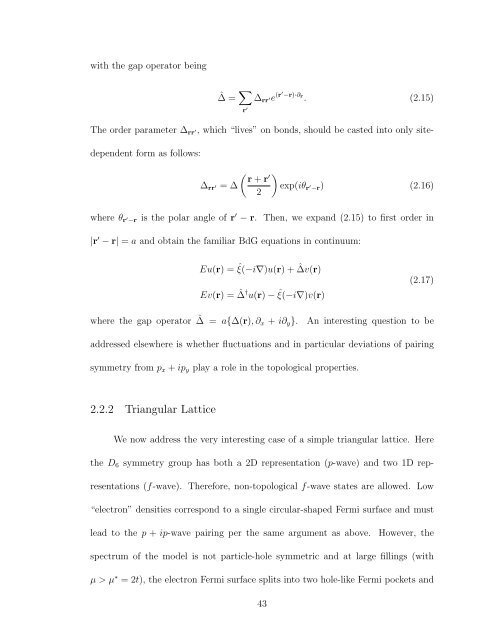ABSTRACT - DRUM - University of Maryland
ABSTRACT - DRUM - University of Maryland
ABSTRACT - DRUM - University of Maryland
Create successful ePaper yourself
Turn your PDF publications into a flip-book with our unique Google optimized e-Paper software.
with the gap operator being<br />
ˆ∆ = ∑ r ′ ∆ rr ′e (r′ −r)·∂ r<br />
. (2.15)<br />
The order parameter ∆ rr ′, which “lives” on bonds, should be casted into only sitedependent<br />
form as follows:<br />
( ) r + r<br />
′<br />
∆ rr ′ = ∆ exp(iθ r<br />
2<br />
′ −r) (2.16)<br />
where θ r ′ −r is the polar angle <strong>of</strong> r ′ − r. Then, we expand (2.15) to first order in<br />
|r ′ − r| = a and obtain the familiar BdG equations in continuum:<br />
Eu(r) = ˆξ(−i∇)u(r) + ˆ∆v(r)<br />
Ev(r) = ˆ∆ † u(r) − ˆξ(−i∇)v(r)<br />
(2.17)<br />
where the gap operator ˆ∆ = a{∆(r), ∂ x + i∂ y }.<br />
An interesting question to be<br />
addressed elsewhere is whether fluctuations and in particular deviations <strong>of</strong> pairing<br />
symmetry from p x + ip y play a role in the topological properties.<br />
2.2.2 Triangular Lattice<br />
We now address the very interesting case <strong>of</strong> a simple triangular lattice. Here<br />
the D 6 symmetry group has both a 2D representation (p-wave) and two 1D representations<br />
(f-wave). Therefore, non-topological f-wave states are allowed. Low<br />
“electron” densities correspond to a single circular-shaped Fermi surface and must<br />
lead to the p + ip-wave pairing per the same argument as above.<br />
However, the<br />
spectrum <strong>of</strong> the model is not particle-hole symmetric and at large fillings (with<br />
µ > µ ∗ = 2t), the electron Fermi surface splits into two hole-like Fermi pockets and<br />
43
















